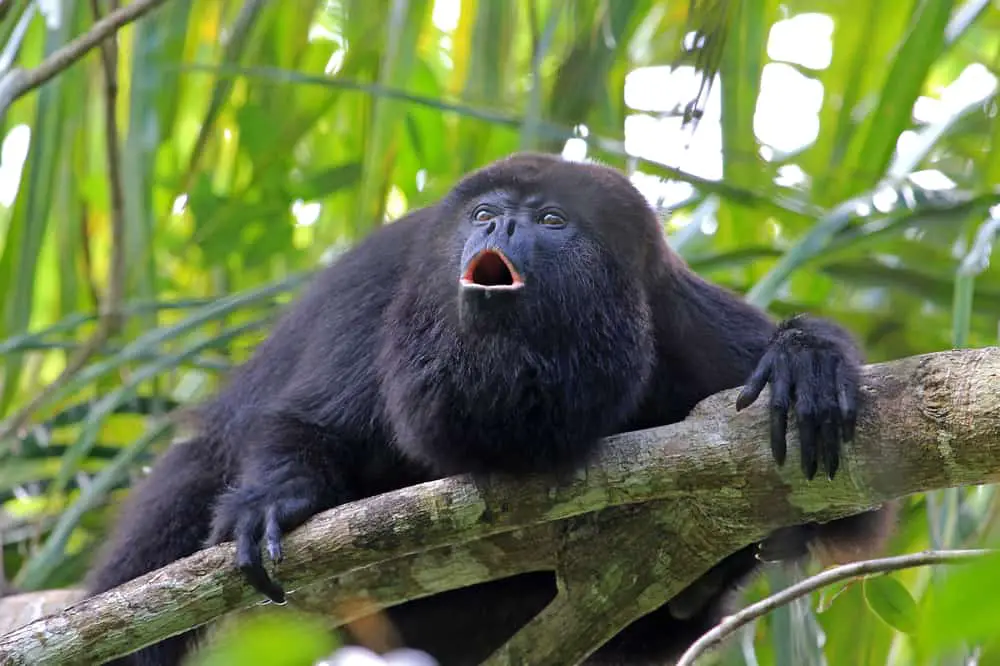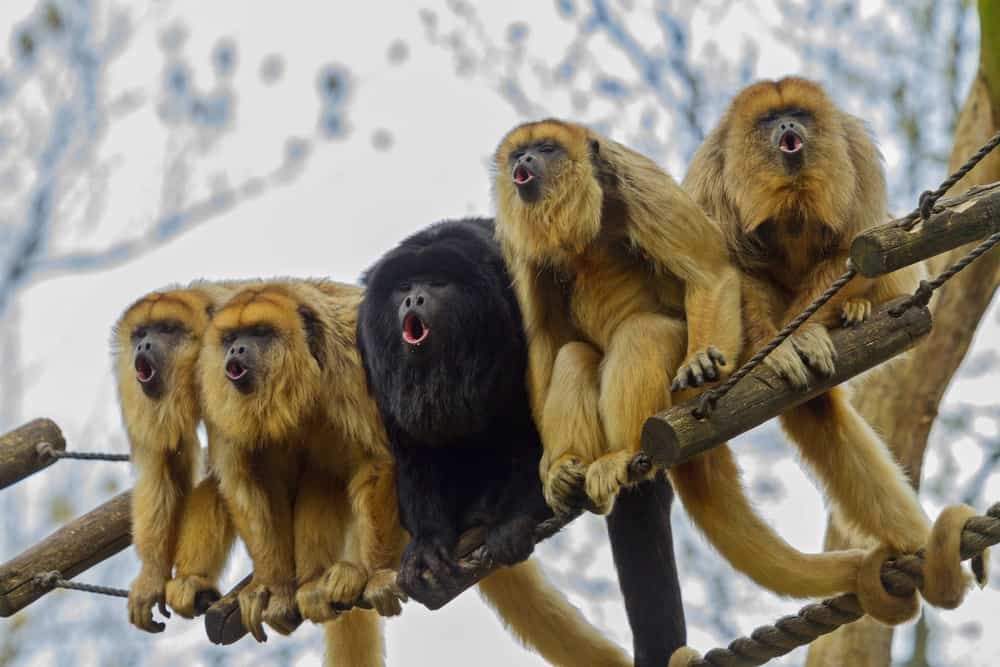Howler monkeys are an iconic species of New World primates. They are widely distributed throughout Central and South America, ranging from Mexico to as far south as Paraguay and Brazil. As the largest monkey in the Americas, howler monkeys have long been a source of fascination for primatologists studying their behavior and ecology.
Howler monkeys possess several distinct morphological features that make them easily recognizable among other primate species. Adults can reach up to thirteen kilograms in weight and 63 centimeters in length; however males tend to be larger than females on average.
Their fur is typically light gray or brownish-red with darker hairs along its backside and tail. Additionally, they possess unique elongated hyoid bones which allow them to produce loud calls heard over great distances – hence their namesake ‘howlers’.
The habitats occupied by howler monkeys vary greatly across their range due mostly to varying environmental conditions. Generally speaking these primates prefer moist tropical forests within lowland areas located close to rivers or streams; however they have also been observed inhabiting dry deciduous forests at higher elevations away from bodies of water during seasonal droughts.
In terms of diet, howler monkeys feed predominantly on leaves supplemented occasionally with fruit and flowers depending on seasonality and availability.

Overview
Howler monkeys are species of primates found in the tropical regions of Central and South America. They can be identified by their distinctive loud calls, which travel up to three miles through dense vegetation. The four recognized howler monkey species include the Black Howler Monkey (Alouatta caraya), Brown Howler Monkey (Alouatta guariba clamitans), Mantled Howler Monkey (Alouatta palliata) and Yucatan Black Howler Monkey (Alouatta pigra).
The habitat ranges of each species vary depending on region. The Black Howler is found in Argentina, Brazil and Paraguay; while the Brown Howlers inhabit eastern and southeastern Brazil. The Mantled Howlers live mainly in Guatemala, El Salvador, Honduras, Nicaragua and Panama; whereas the Yucatán Black Howlers primarily occupy Mexico’s Yucatán Peninsula.
All four howler monkey species share certain physical characteristics: long prehensile tails for grasping branches when climbing trees; large eyes that allow them to see well during both day and night; and enlarged hyoid bones used for amplifying vocalizations. These animals typically feed on leaves and fruit from high tree canopies as well as flowers and small insects such as beetles or ants near the ground level.
In sum, howler monkeys are a type of primate characterized by their distinct calls and various habitat ranges across parts of Central and South America. Their physical features enable them to survive in jungle environments where they feed predominantly on leaves, fruit, flowers, and insects.
Howler Monkeys’ Predators Exposed: Unveiling the Threats
Habitat And Distribution
The habitat and distribution of the Howler Monkey is quite diverse. Their range spans from Central America to South America, covering an estimated 25 countries in total. The geographical distribution of this species varies depending on its subspecies, with each occupying different regions throughout their natural habitats.
In terms of habitat types, the majority of the areas that are home to Howler Monkeys consist of tropical forests or dry deciduous woodlands. They typically reside near water sources such as rivers, lakes and swamps and prefer spots with dense vegetation for shelter. Additionally, they can be found at elevations ranging from sea level up to 1,000 meters above it in mountainous regions.
Howler Monkeys have adapted well to various environmental conditions over time, allowing them to occupy a wide variety habitat range across Latin America. As a result, they are able to coexist with other primate species within their respective ranges while still maintaining some degree of separation between them.
Physical Characteristics
Howler monkeys are primates of the family Atelidae that inhabit tropical forests from Central America to South America. These primates have a distinctive physical appearance with fur color ranging from yellow-brown through to black, depending on species.
With regard to body size, howler monkeys are typically larger than other New World monkeys and can reach an average length between 30 and 77 cm (12–30 in).
They also possess long tails measuring up to 81 cm (32 in), allowing the animals increased flexibility for climbing trees. In addition, their facial features include large protruding jaws and nostrils which turn upwards towards their eyes providing them with a distinct look amongst other primate species.
In terms of vocalizations, howler monkeys are renowned for their loud calls as they can be heard over great distances due to their specialized anatomy. Their enlarged hyoid bone increases resonance within the throat making it possible for these primates to create sound at such high volumes. Consequently, this has led some researchers to refer to howlers as “the loudest land animal”.
Given their unique characteristics, it is clear why howler monkeys remain one of the most recognizable primate species among humans today.
Behavior And Social Structure
Howler monkeys are highly social primates with complex group dynamics. Generally, they live in multi-male and multi-female groups of two to twelve individuals, though larger aggregations have been observed.
Social structure is hierarchical within the group, which helps reduce aggression between members by establishing a dominance order. Communication methods include vocalizations such as loud howls that can travel long distances through their forest habitats and facial expressions that help convey moods or intentions.
In regards to territorial behavior, each troop usually has an area it maintains exclusively for feeding and resting but will sometimes overlap with another troop’s home range when resources become limited. This minimizes conflicts over territory while still allowing access to food sources.
Howlers also employ strategies related to predator avoidance including mobbing and alarm calls to alert other members of potential danger.
Given these behaviors, the following list outlines some key characteristics of howler monkey social dynamics:
- Multi-male/multi-female troops organized hierarchically
- Vocalizations used for communication & territoriality
- Facial expressions indicating different moods or intentions
- Overlapping territories during times of resource scarcity
- Mobbing & alarm calls for avoiding predators
These traits serve to ensure survival and promote stability among howler monkey populations in their natural environment.
Diet
The dietary habits of howler monkeys are varied, with their diets ranging from fruits and leaves to insects. As is typical for primates, the diet of howler monkeys consists mainly of plant-based foods such as fruit, flowers, buds, shoots, nuts and seeds.
They supplement their vegetarian diet with occasional preys like birds’ eggs, lizards or small rodents. Howler monkeys may also feed on the nectar of certain plants when available. Depending on season and location, other sources of protein can be added to the diet including honeybee larvae and moths.
When studying primate diets it is important to consider that species will adapt according to availability in their particular environment. This means that different monkey populations throughout a species’ range may have slightly varying diets based upon what resources are abundant in each area.
For example, some groups of howler monkeys in Central America consume large quantities of tree gum while others do not because this resource is not readily available everywhere they live.
Additionally, some population studies suggest that individual preferences affect dietary decisions among various members of a troop; meaning one group member might prefer more leaf material than another in order to meet its nutritional needs.
Understanding the general dietary patterns across a species range helps researchers identify why some populations thrive whereas others struggle with fewer resources available. In addition to investigating the types of food consumed by howler monkeys through direct observation methods it has been useful to analyze fecal samples collected from study sites which enables us to measure nutrient content and gain insight into overall health condition within a given population.

Reproduction And Lifespan
Howler monkeys reproduce seasonally, with the peak mating period occurring between April and June in Central America. The gestation period is approximately six months long and typically results in a single infant being born.
Infant howler monkeys are altricial at birth, meaning they require significant parental care and support to survive. They cling tightly onto their mothers for up to five weeks after birth, rarely leaving her side until about this time when the mother reintroduces them into the group’s social dynamic.
During infancy, infants will ride on their mothers’ backs or hold onto her fur as she moves from location to location. Mothers of howler monkey infants also provide protection against predators by keeping the infant close while alerting other adults of potential danger through loud vocalizations specific to predator threats.
The lifespan of a howler monkey ranges anywhere from 15-20 years depending upon environmental factors such as predation risk and food availability. However, some captive individuals have been known to live over 25 years given proper nutrition and healthcare.
Howlers tend to reach sexual maturity around four years old but usually do not mate until closer to seven years old due to competition among males for access to reproductive females within a particular group setting.
Conservation Status
Recent studies of the howler monkey have revealed alarming statistics regarding their conservation status. The International Union for Conservation of Nature (IUCN) has classified this species in its red list as Endangered, due to various factors such as habitat loss and human exploitation.
These primates are particularly vulnerable to population decline due to low reproductive capacity and a slow maturation rate. As a result, they require specific protection measures from wildlife authorities if their numbers are to be maintained.
In some areas where the howler monkey is present, there have been efforts to protect them through different types of conservation projects that aim at preserving their habitats and limiting hunting practices by humans.
Such initiatives include education programs targeted towards local communities about the importance of protecting these animals and regulation imposed on exploiting resources within these territories. Moreover, national parks or protected reserves can play an important role in avoiding further fragmentation of forests where these primates live in.
Despite all mentioned actions, illegal activities related to poaching still persist in many parts of the range area which represent a major threat for this primate’s survival.
To address this issue it is necessary for governments to strengthen existing laws against poaching and wildlife trafficking while raising awareness among citizens about the critical situation faced by endangered species like howler monkeys. In addition, international collaboration should be encouraged between countries with shared populations so resource management plans cross-border regions can be efficiently established
Conclusion
The howler monkey is an iconic species of primate found throughout the tropical regions of Central and South America. Its unique coloration, loud vocalizations, and impressive physical characteristics make it one of the most recognizable primates in its range. While they inhabit a wide variety of habitats, their numbers have been steadily declining due to deforestation and hunting pressure.
Howler monkeys are medium-sized primates with long prehensile tails that allow them to balance while moving through dense vegetation. They live in large troops composed of both sexes and many different age classes.
Their diet consists mostly of leaves but also includes flowers, fruits, nuts, insects and bird eggs when available. Breeding usually occurs once per year resulting in single births after six months gestation period; females reach sexual maturity at 4-5 years old while males take longer to mature around 7-8 years old.
Unfortunately for these animals, human activities such as deforestation have resulted in a considerable decline in population size across much of their range. This has led to several conservation initiatives aiming at preserving remaining populations from further degradation or destruction by reintroducing captive individuals into areas where suitable habitat still exists.
Despite this efforts however, only time will tell if we can successfully secure the future viability of howler monkeys within their native ranges before they become extinct like so many other species lost forever.
